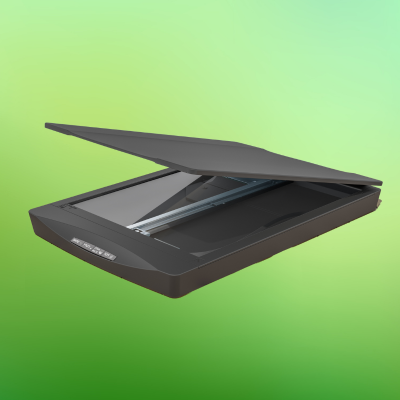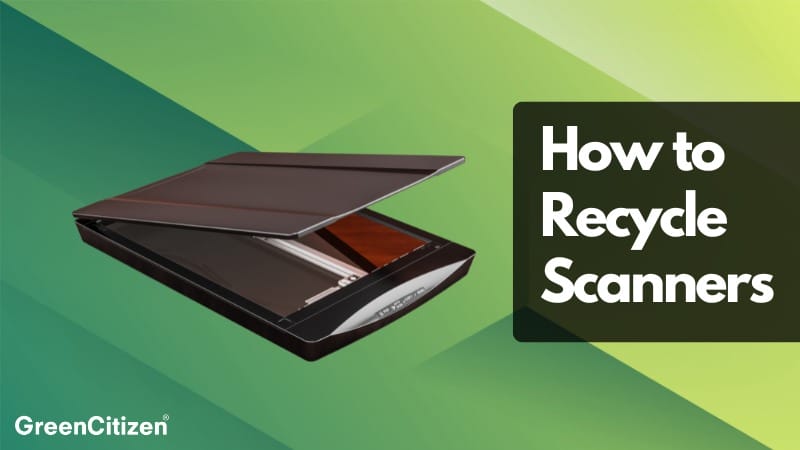Most offices don’t think twice about an old scanner once a new one arrives. But every flatbed or sheet-fed scanner—and even those built into all-in-one printers—contains valuable parts like metal, plastic, glass, motors, and circuit boards. Some models even store bits of data, such as scanned job logs or saved contacts.
So, how do you recycle scanners?
The best way is to send them to a certified electronics recycler, or schedule a business pickup. These recyclers safely wipe any stored data, take the device apart, and separate materials like glass, metal, copper wiring, and plastics for proper recycling. You’ll also receive a Certificate of Recycling and a Certificate of Data Destruction to ensure everything is done by the book.
Scanners might not take up much space, but when they start piling up in the IT room, they can quickly become a headache. Proper recycling keeps your workspace clean, your data safe, and your company aligned with environmental and privacy standards. And if you’re based in the San Francisco Bay Area, it’s even easier with local certified pickup services.
💡 Key Takeaway: How to Recycle Scanner
To recycle an office scanner, choose a certified electronics recycler that offers data wiping, secure pickup, and full documentation. Flatbed, sheet-fed, and MFP scanners can all be recycled, and may contain sensitive data that must be cleared before disposal.

Bay Area’s Trusted Scanner Recycling Partner
Don’t Let Old Scanners Become E-Waste — GreenCitizen Offers Secure, Responsible Recycling in the Bay Area.
Can You Recycle Scanners?
Yes, you can absolutely recycle office scanners—and you should.
Flatbed scanners, sheet-fed models, and even all-in-one printers with scanning functions all qualify as electronic waste. That means they contain valuable materials like metal, plastic, glass, and small circuit boards that can be recovered and reused. Tossing them in the trash not only wastes resources but also risks sending hazardous components into landfills.
Recycling scanners are simple. Most certified e-waste recyclers will accept them, especially if you’re recycling as part of a business or IT equipment cleanup. If you’re in the San Francisco Bay Area, you can even schedule a pickup so everything is handled for you—no need to haul anything across town.
Just keep in mind that some office scanners may store data, like scanned documents, job histories, or contact info. We’ll show you how to clear that before recycling in a later section.
For now, what matters most is this: if you’ve got old scanners piling up, there’s a safe and responsible way to get rid of them. And it starts with choosing the right recycler.
Which Parts of a Scanner Are Recyclable?
Almost every part of a scanner can be recycled in some way. Inside that familiar glass-and-plastic shell are valuable materials that can be recovered, reused, and kept out of landfills.
A typical office scanner contains a mix of metal, glass, plastic, and electronic components. The metal frame and power supply can be melted down and reused. The glass platen—the surface where documents are placed—can be processed into new glass products.
Plastic covers and trays are shredded and reformed into pellets for manufacturing. Even smaller pieces like motors, circuit boards, and wiring hold copper, aluminum, and trace precious metals that specialized recyclers extract and return to the production cycle.
The recycling process not only conserves raw materials but also keeps harmful components—such as coatings, small capacitors, or LED backlights—from entering the environment. When handled by a certified electronics recycler, these materials are carefully separated and processed using safe, environmentally responsible methods.
In short, nearly every part of your scanner has a second life. The key is choosing a recycler that has the right certifications and the tools to handle electronic waste properly.
What Materials Can You Retrieve from a Scanner?

Scanners are made up of many different components—metal, plastic, glass, motors, wiring, and electronics—most of which can be recovered during recycling. When sent to a certified recycler, these materials are safely removed and processed for reuse instead of ending up in a landfill.
Let’s break it down by scanner type:
Flatbed Scanners
Flatbed scanners have a large glass platen, a sturdy metal chassis, and a motorized scanning bar with lights and sensors. Inside, they also contain plastic shells, copper wiring, and small circuit boards.
Materials recovered include:
- Glass from the platen
- Steel or aluminum from the frame
- ABS or polycarbonate plastic from the outer shell
- Copper from internal wiring and motor coils
- Gold, silver, and palladium from printed circuit boards (PCBs)
- Rare earth elements from LEDs or image sensors
While the amounts are small per device, they add up quickly when large batches are recycled.
Sheet-Fed Scanners (ADF / Duplex)
These compact units are designed to feed documents through rollers and scan both sides. They contain fewer glass components but more mechanical parts like rubber rollers, motors, and gears—plus small PCBs and connectors.
Materials recovered include:
- Copper windings from feed motors
- Steel parts from drive gears and support structures
- Plastic rollers and trays
- Gold and silver traces from control boards
- Aluminum from casing or motor housings
These components are valuable for material recovery, especially in bulk recycling operations.
Multi-Function Printers (MFPs with Scanners)
MFPs combine scanning, printing, and copying in one device. That means more parts—and more materials to recover. In addition to scanning components, they often include larger PCBs, flash memory or hard drives, toner systems, and power supplies.
Materials recovered include:
- Hard drive or flash memory chips (must be wiped or destroyed)
- Copper, aluminum, and gold from complex circuit boards
- Toner residue, handled separately under e-waste regulations
- Plastics and glass from the scanner bed and housing
- Steel frames, motors, and power supply units
Because MFPs store more data, they should always go through data destruction as part of the recycling process.
Recycling office scanners isn’t just about reducing waste—it’s about recovering rare and valuable resources that would otherwise be lost. When handled by a certified electronics recycler, these materials are extracted safely, sorted, and sent back into the supply chain—helping power the next generation of devices.
Quick Summary
Scanners are packed with recyclable materials like glass, plastic, metal, copper wiring, and circuit boards. These devices contain small amounts of gold, silver, palladium, and rare earth elements that are recovered by certified recyclers and put back into use—reducing waste and conserving natural resources.
How to Recycle Scanners the Right Way
Recycling a scanner isn’t just about dropping it off at the nearest electronics bin. To do it right—especially for offices—you’ll want to follow a few key steps to make sure everything is handled securely, safely, and in line with recycling regulations.
Start by choosing a certified electronics recycler, preferably one that’s R2 or e-Stewards certified.
These recyclers follow strict standards for data security, environmental safety, and responsible downstream processing.
If you’re dealing with multiple scanners—or decommissioning a batch of old office equipment—it’s best to schedule a business pickup so the recycler can handle everything in bulk.
Next, make sure to wipe any stored data on networked or multi-function scanners. Many models keep address books, scan histories, or saved jobs. We’ll walk you through how to clear that in the next section.
Before pickup or drop-off, remove cables, trays, and ink or toner cartridges, and group your devices together. Most recyclers prefer that items be boxed or palletized, especially for office pickups.
Once collected, a certified recycler will:
- Sanitize any remaining data
- Dismantle the device
- Sort materials for recovery (metal, glass, plastic, and electronics)
- Provide a Certificate of Recycling and, if applicable, a Certificate of Data Destruction
Following this process ensures your old scanners are handled responsibly, your data stays secure, and your company stays compliant with environmental and privacy standards.
Do Office Scanners Store Data?
In many cases, yes—office scanners can store data, especially if they’re networked or part of a multi-function printer (MFP). While not all scanners save full documents, many keep temporary records like address books, scan logs, saved job history, or user credentials.
This data lives in small amounts of onboard memory, such as NVRAM, flash storage, or even built-in hard drives. If this data isn’t wiped before recycling, it could be exposed—even after the device leaves your office.
How to Wipe a Scanner Before Recycling
Before recycling, take a few extra steps to ensure your scanner is data-free:
1. Factory Reset the Device
Use the admin settings to restore the scanner to factory defaults. This usually clears job history, stored scans, and settings.
2. Delete Address Books and Logs
Manually remove any saved email addresses, scan destinations, or recent jobs stored in the scanner’s memory.
3. Consult the Manual (if needed)
Some devices have extra security steps or hidden admin menus. Check the manufacturer’s guide for instructions.
4. Mark It as Wiped
Label the device or document the reset in your inventory if you’re handling multiple devices.
5. Ask for a Certificate of Data Destruction
If you’re working with a certified recycler, request a formal CoD as proof that any residual data was properly destroyed.
Need Help? Ask About ITAD Services
If you’re disposing of multiple devices or decommissioning an entire office setup, consider using a certified ITAD service.
GreenCitizen offers full IT Asset Disposition with data wiping, audit trails, serialized asset tracking, and certified documentation—ideal for businesses that want a hands-off, secure process.
Taking time to wipe scanners—or working with an ITAD partner that does it for you—helps protect sensitive information, maintain compliance, and give your team peace of mind.
💡 Pro Tip: Recycling in Bulk? Go with ITAD
If your office is recycling multiple scanners—or a mix of printers, copiers, and other electronics—it’s faster, safer, and far more efficient to use an IT Asset Disposition (ITAD) service.
This approach is especially useful for businesses that need to meet strict data privacy regulations, like HIPAA, GDPR, or internal IT security policies. Whether you’re clearing out an office or upgrading all your scanners at once, ITAD takes the guesswork and risk out of the equation.
Where to Recycle Office Scanners
If you’re wondering where to recycle your old scanners, the best option is to go with a certified electronics recycling service—especially one that caters to businesses and offers pickup.
In the San Francisco Bay Area, many offices turn to local e-waste recyclers who are R2 or e-Stewards certified. These certifications ensure that the scanners are recycled responsibly, that any stored data is properly wiped or destroyed, and that materials are handled safely and legally.
You can either drop off your scanners at a designated recycling center or schedule a business pickup, which is much more convenient if you’re disposing of multiple devices or coordinating with your IT team. For added security and transparency, be sure to ask whether the recycler provides:
- A Certificate of Recycling (CoR)
- A Certificate of Data Destruction (CoD)
- A clear chain of custody for your devices
Working with a trusted local provider also helps keep your recycling process in compliance with California’s e-waste laws and supports responsible downstream processing.
Why Choose GreenCitizen for Scanner Recycling?
If you’re located in the San Francisco Bay Area, GreenCitizen offers a fast, secure, and certified solution for recycling office scanners—whether you’re getting rid of a single device or decommissioning dozens.
As a certified R2 recycler, GreenCitizen follows strict environmental and data security standards. That means every scanner is processed with care—materials are recovered responsibly, and any stored data is properly wiped or destroyed.
When you book a business e-waste pickup with GreenCitizen, you’ll get:
- Onsite pickup across the Bay Area
- Serialized tracking of your devices
- Certificate of Recycling (CoR)
- Certificate of Data Destruction (CoD) for any device that may store data
- A documented chain of custody for audit and compliance records
Whether you’re a small business or a large enterprise, GreenCitizen helps you recycle scanners the right way—compliantly, securely, and sustainably.

Bay Area’s Trusted Scanner Recycling Partner
Don’t Let Old Scanners Become E-Waste — GreenCitizen Offers Secure, Responsible Recycling in the Bay Area.
FAQ: Scanner Recycling for Businesses
Yes, many office scanners—especially networked models and MFPs—can store data such as address books, scan logs, or cached files in NVRAM or flash memory. It’s always a good idea to perform a factory reset or request data wiping before recycling.
Most scanners have a factory reset option in the admin settings. You can also manually delete saved contacts and logs. If you're unsure, consult the user manual or ask your recycler about secure ITAD services with certified data destruction.
Yes. All types of scanners—flatbed, sheet-fed, duplex, wide-format, and MFPs—are classified as electronic waste and should be recycled through certified e-waste facilities.
Absolutely. Multi-function printers with scanners can be recycled, but they may contain hard drives or flash memory that should be wiped before disposal. Many recyclers treat them as part of broader IT asset recycling.
A certified recycler should provide a Certificate of Recycling (CoR) and, if the device stores data, a Certificate of Data Destruction (CoD). For businesses, a chain-of-custody report or audit log is also recommended.
Costs vary by quantity and location. In the San Francisco Bay Area, business pickups may be priced per unit or per pallet. Bulk rates are often available, and some recyclers offer quotes upfront.
Recyclers dismantle scanners to recover materials like glass, copper, steel, plastic, and precious metals from circuit boards. These materials are sorted and sent for reuse, while any hazardous components are safely disposed of.
Final Thoughts: Recycle Scanners the Right Way
Whether you’re replacing a single flatbed scanner or decommissioning a room full of MFPs, recycling them the right way matters. These devices may seem small, but they contain valuable materials and sometimes sensitive data—both of which should be handled with care.
By choosing a certified electronics recycler, performing basic data wipes, and requesting the right documentation, you’re not just clearing out space—you’re protecting your business, the environment, and your peace of mind.
And if you’re in the San Francisco Bay Area, companies like GreenCitizen make the process easy with on-site pickup, secure data destruction, and full compliance documentation from start to finish.
Ready to recycle your office scanners?
Schedule a pickup today and let the experts handle the rest.
